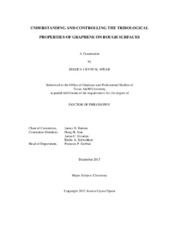| dc.description.abstract | Understanding and controlling friction, adhesion and wear is critical for the continued growth and utilization of emerging nanotechnologies such as micro- and nano-electromechanical systems devices (NEMS/MEMS). The challenge of operating NEMS/MEMS with contacting interfaces stems from the large surface-to-volume ratio of these devices where surface forces dominate the interfacial interactions. Capillary forces, even in low humidity, can increase adhesion causing high friction and sticking as well as catalyzing wear on the surface. In addition, the nanoscale roughness of surfaces leads to high pressures and shear forces at asperity-asperity contacts, ultimately leading to device failure.
To mitigate friction and wear of silicon surfaces, two-dimensional solid state lubricants such as graphene have drawn increased interest due to the rapid development of fabrication techniques. One of the newest carbon nanomaterials, graphene is a single atomic layer of highly ordered pyrolytic graphite. Studies over the past decade on graphene have elucidated a variety of unique properties such as large out-of-plane flexibility, strong in-plane modulus and chemical inertness which have made it an ideal candidate for use as a protective surface coating. Although graphene can easily adopt a similar morphology to its underlying substrate, the properties of graphene are largely influenced by its environmental and substrate interactions.
To better understand and address the challenges of graphene’s substrate mediated properties for applications to NEMS/MEMS, this dissertation includes research on the fundamental interactions between graphene and rough substrates. Using Atomic Force Microscopy, the morphology of graphene on rough surfaces was shown to partially conform to the substrate roughness as a result of the size and spacing of the nanoparticle asperities and a balance between the interfacial adhesion and strain in the graphene lattice. This type of morphology decreases the contact between graphene and the substrate resulting in a weakly bound state that is undesirable for use as a protective coating. However, exploring the mechanical properties showed that under increased loading the conformity could be controllably increased and the frictional properties showed a dependence on the asperity-asperity contact area unique to these types of rough substrate geometries. Based on these results, further research was explored to control the tribological properties of graphene by systematically changing the nanoscale roughness and surface chemistry to increase graphene adhesion to the substrate for better friction modification. | en |


